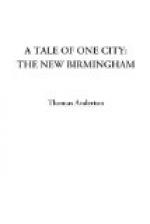These are just a few of the more important changes that have taken place, with one exception, namely, the disappearance of Christ Church. I almost shed tears to see the demolition of this church and landmark that had so many old associations. Some of these were not always of a pleasant and joyous character, for in days past the Sunday services were very long, and the sermons anything but short.
I hope my memory has not “berayed” me in making these little reminiscent remarks. I did not make notes in my early days, and now in my later years I may make little mistakes; but I do not think I have tripped very much.
X.
The city fringe.
It is my constant habit to take little runs into the outskirts of our city, and when doing so I often stare with all my eyes as I note what has taken place in a limited number of years. Districts hardly more than a mile or so from the centre of the city, which in my boyhood were fields and meadows, are now laid out into streets and covered with houses and shops. Indeed, I sometimes feel very aged when I look upon places where as a boy I went fishing for small fry, and now find the river that afforded me such juvenile sport is, owing to the enhanced value of laud, compressed into the dimensions of a fair-sized gutter, with houses and small factories closely packed on its margin covering every foot of ground.
I go in another direction, and scarcely farther than the distance just named, and I come to a spot where once stood the fine large park (Aston) which I remember was enclosed by a brick wall on every side. Scarcely a trace of this extensive old wall can I now see, and the site of the old park, or nearly the whole of it, is now covered with streets and buildings. Aston Hall, the grand old Elizabethan house built by the Holtes in the time of Charles I., still stands in a state of good preservation, and is fortunately now the property of the city, together with some forty acres of surrounding land, which is, as is well known, used as a public recreation ground.
To speak a little more in detail, I am not the only person living who remembers “Pudding Brook” and “Vaughton’s Hole.” The name of “Padding Brook” was, in my boyish days, given to a swampy area of fields now covered by Gooch Street and surrounding thoroughfares. Pudding Brook proper was, however, a little muddy stream that flowed or oozed along the district named and finally emptied itself into the old moat not far from St. Martin’s Church. Vaughton’s Hole, to my juvenile mind, was represented by a deep pool in the River Rea, where something direful took place, in which a Mr. Vaughton was tragically concerned. The real facts are—at least, so I read—that there was a clay pit, sixty feet deep of water, situated near the Rea, and in this pit at least one man was drowned. The place was named after an old local family named Vaughton, who owned considerable property in the neighbourhood of the present Gooch Street.




